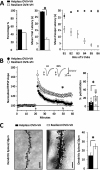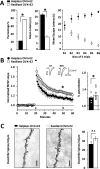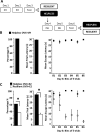17β Estradiol increases resilience and improves hippocampal synaptic function in helpless ovariectomized rats
- PMID: 24636504
- PMCID: PMC4065496
- DOI: 10.1016/j.psyneuen.2014.01.004
17β Estradiol increases resilience and improves hippocampal synaptic function in helpless ovariectomized rats
Abstract
Memory impairment is the most commonly reported cognitive symptom associated with major depressive disorder. Decreased hippocampal volume and neurogenesis in depression link hippocampal dysfunction with deficits in memory. Stress decreases hippocampal dendritic spine density and long-term potentiation (LTP) at glutamate synapses, a cellular correlate of learning and memory. However, elevated plasma levels of 17β estradiol (E2) during proestrus increase hippocampal structure and function, directly opposing the negative consequences of stress. In women, significant fluctuations in ovarian hormones likely increase vulnerability of hippocampal circuits to stress, potentially contributing to the greater incidence of depression compared to men. Using the learned helplessness model of depression and ovariectomized female rats, we investigated whether acquisition of helplessness and hippocampal synaptic dysfunction is differentially impacted by the presence or absence of plasma E2. We find that inescapable shock induces a greater incidence of helplessness in vehicle- versus E2-treated OVX rats. In the vehicle-treated group, LTP was absent at CA3-CA1 synapses in slices only from helpless rats, and CA1 spine density was decreased compared to resilient rats. In contrast, significant LTP was observed in slices from E2-treated helpless rats; importantly, spine density was not different between E2-treated helpless and resilient rats, dissociating spine density from the LTP magnitude. We also find that E2 replacement can reverse previously established helpless behavior. Thus, our results show that E2 replacement in OVX rats increases resilience and improves hippocampal plasticity, suggesting that E2 therapy may increase resilience to stress and preserve hippocampal function in women experiencing large fluctuations in plasma estrogen levels.
Keywords: Dendritic spines; Estrogen; Hippocampus; LTP; Learned helplessness; Stress.
Copyright © 2014 Elsevier Ltd. All rights reserved.
Figures





References
-
- Bath KG, Chuang J, Spencer-Segal JL, Amso D, Altemus M, McEwen BS, Lee FS. Variant brain-derived neurotrophic factor (Valine66Methionine) polymorphism contributes to developmental and estrous stage-specific expression of anxiety-like behavior in female mice. Biol. Psychiatry. 2012;72:499–504. - PMC - PubMed
-
- Campbell S, Marriott M, Nahmias C, MacQueen GM. Lower hippocampal volume in patients suffering from depression: a meta-analysis. Am. J. Psychiatry. 2004;161:598–607. - PubMed
-
- Chen X, Guo T, Li B. Influence of prophylactic oophorectomy on mood and sexual function in women of menopausal transition or postmenopausal period. Arch. Gynecol. Obstet. 2013;288:1101–1106. - PubMed
Publication types
MeSH terms
Substances
Grants and funding
LinkOut - more resources
Full Text Sources
Other Literature Sources
Miscellaneous

